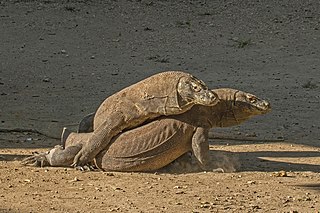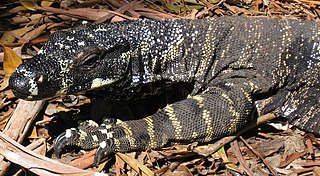
The Lepidosauria are reptiles with overlapping scales. This subclass includes Squamata and Rhynchocephalia. It is a monophyletic group and therefore contains all descendants of a common ancestor. Squamata includes snakes, lizards, and amphisbaenia. Rhynchocephalia was a widespread and diverse group 220-100 million years ago; however, it is now represented only by the genus Sphenodon, which contains a single species of tuatara, native to New Zealand. Lepidosauria is the sister taxon to Archosauria, which includes Aves and Crocodilia. Lizards and snakes are the most species-rich group of lepidosaurs and, combined, contain over 9,000 species. There are many noticeable distinguishing morphological differences between lizards, tuataras, and snakes.

Amphisbaenia is a group of usually legless squamates, comprising over 200 extant species. Amphisbaenians are characterized by their long bodies, the reduction or loss of the limbs, and rudimentary eyes. As many species have a pink body and scales arranged in rings, they have a superficial resemblance to earthworms. While the genus Bipes retains forelimbs, all other genera are limbless. Although superficially similar to the snakes and blind lizards, recent phylogenetic studies suggest that they are most closely related to the true lizards. Amphisbaenians are widely distributed, occurring in North America, Europe, Africa, South America, Western Asia and the Caribbean. They are not found east of the Caspian Sea. Most species are less than 6 inches (150 mm) long.

Dibamidae or blind skinks is a family of lizards characterized by their elongated cylindrical body and an apparent lack of limbs. Female dibamids are entirely limbless and the males retain small flap-like hind limbs, which they use to grip their partner during mating. They have a rigidly fused skull, lack pterygoid teeth and external ears. Their eyes are greatly reduced, and covered with a scale.

The Varanidae are a family of lizards in the superfamily Varanoidea within the Anguimorpha group. The family, a group of carnivorous and frugivorous lizards, includes the living genus Varanus and a number of extinct genera. Varanus includes the Komodo dragon, crocodile monitor, savannah monitor, the goannas of Australia and Southeast Asia, and various other species with a similarly distinctive appearance. Their closest living relatives are the anguid and helodermatid lizards.

Ophidia is a group of squamate reptiles including modern snakes and all reptiles more closely related to snakes than to other living groups of lizards.

Mosasaurs comprise a group of extinct, large marine reptiles containing 40 genera in total. Their first fossil remains were discovered in a limestone quarry at Maastricht on the Meuse in 1764. They belong to the order Squamata, which includes lizards and snakes.

Buitreraptor is a genus of dromaeosaurid dinosaurs that lived during the Late Cretaceous of Argentina at the Candeleros Formation. Buitreraptor was described in 2005 and the type species is Buitreraptor gonzalezorum. It was rooster-sized and had a very elongated head with many small teeth.

Pythonomorpha was originally proposed by paleontologist Edward Drinker Cope (1869) as a reptilian order comprising mosasaurs, which he believed to be close relatives of Ophidia (snakes). The etymology of the term Pythonomorpha comes from the Greek Python and morphe ("form"), and refers to the generally serpentine body plan of members of the group. Cope wrote, "In the mosasauroids, we almost realize the fictions of snake-like dragons and sea-serpents, in which men have been ever prone to indulge. On account of the ophidian part of their affinities, I have called this order Pythonomorpha." Cope incorporated two families, the Clidastidae and the Mosasauridae.

Varanoidea is a superfamily of lizards, including the well-known family Varanidae. Also included in the Varanoidea are the Lanthanotidae, and the extinct Palaeovaranidae.

Mecistotrachelos is an extinct genus of gliding reptile believed to be an archosauromorph, distantly related to crocodylians and dinosaurs. The type and only known species is M. apeoros. This specific name translates to "soaring longest neck", in reference to its gliding habits and long neck. This superficially lizard-like animal was able to spread its lengthened ribs and glide on wing-like membranes. Mecistotrachelos had a much longer neck than other gliding reptiles of the Triassic such as Icarosaurus and Kuehneosaurus. It was probably an arboreal insectivore.

Eupodophis is an extinct genus of snake from the Late Cretaceous period. It has two small hind legs and is considered a transitional form between Cretaceous lizards and limbless snakes. The feature, described as vestigial, was most likely useless to Eupodophis. The type species Eupodophis descouensi was named in 2000 and resides now in the paleontology section of the Mim Museum in Beirut, Lebanon. The specific name is dedicated to the French naturalist Didier Descouens.

Platynota is a group of anguimorph lizards and thus belongs to the order Squamata of the class Reptilia. Since it was named in 1839, it has included several groups, including monitor lizards, snakes, mosasaurs, and helodermatids. Its taxonomic use still varies, as it is sometimes considered equivalent to the group Varanoidea and other times viewed as a distinct group. It is phylogenetically defined as a clade containing Varanidae. It also includes many extinct species.
Liushusaurus is an extinct genus of lizard described by Susan E. Evans and Yuan Wang in 2010. The genus has a single species, Liushusaurus acanthocaudata, and is known from eight fossils, several of which preserve soft tissue detail. The specimens were found in the Lower Cretaceous aged Yixian Formation of Northeast China. Liushusaurus is one of eight lizards that are known and have been named from the Yixian Formation, part of the diverse Jehol Biota ecosystem.
Acteosaurus is an extinct genus of aquatic lizard that lived in the upper Cretaceous period. Its species, A. tommasinii and A. crassicostatus, were described in 1860 and 1993. Though A. crassicostatus is probably a junior synonym for Adriosaurus suessi, A. tommasinii was found to be similar to coniasaurs, mosasauroids, and a sister taxon to modern snakes in 2010.
Telmasaurus is an extinct genus of varanoid lizard from the Late Cretaceous of Mongolia. Fossils have been found from the Djadokha and Barun Goyot Formations that date between the early and middle Campanian stage from approximately 80 to 75 million years ago. The type species Telmasaurus grangeri was named in 1943.
Proplatynotia is an extinct genus of varanoid lizard from the Late Cretaceous of Mongolia. Fossils have been found in the Barun Goyot Formation, which is mid-Campanian in age. The type and only species, P. longirostratia, was named in 1984.

Tetrapodophis is an extinct genus of squamate from the Early Cretaceous. It was previously thought to be one of the oldest members of Ophidia. However it is currently thought to be a dolichosaurid based morphological analysis of the hind limbs. This species existed in the Cretaceous Period about 120 million years ago, located in modern day Brazil. This four legged animal is around 12 inches long, weighing around 15-17 ounces.

Eichstaettisaurus is a genus of lizards from the Late Jurassic and Early Cretaceous of Germany, Spain, and Italy. With a flattened head, forward-oriented and partially symmetrical feet, and tall claws, Eichstaettisaurus bore many adaptations to a climbing lifestyle approaching those of geckoes. The type species, E. schroederi, is among the oldest and most complete members of the Squamata, being known by one specimen originating from the Tithonian-aged Solnhofen Limestone of Germany. A second species, E. gouldi, was described from another skeleton found in the Matese Mountains of Italy. Despite being very similar to E. schroederi, it lived much later, during the Albian stage. Fossils of both species show exceptional preservation due to deposition in low-oxygen marine environments.

Dolichosauridae is a family of Late Cretaceous aquatic varanoid lizards closely related to the mosasaurs. The family contains seven genera.

Ophidiomorpha is a clade composed of snakes and their primitive and early relatives proposed by Palci and Caldwell (2007) The clade was defined as a node-based clade containing the most recent common ancestor of dolichosaurs, adriosaurs, Aphanizocnemus, and fossil and extant Ophidia and all of its descendants.

















